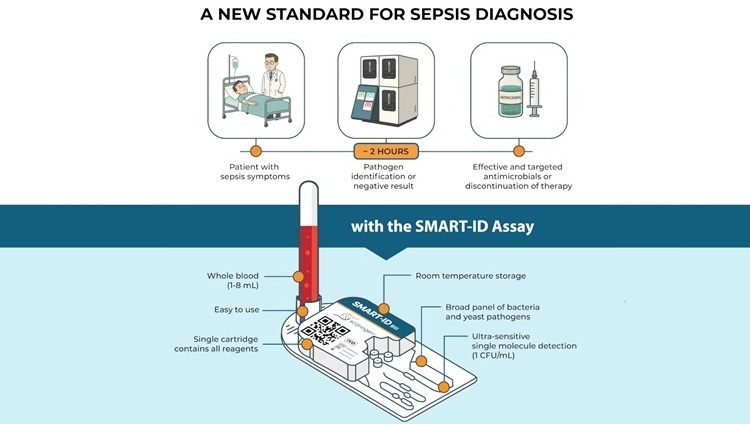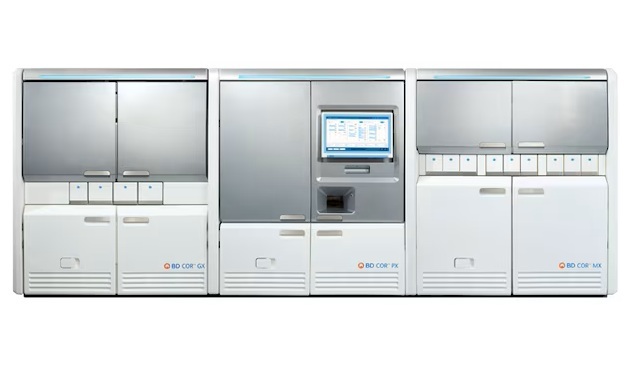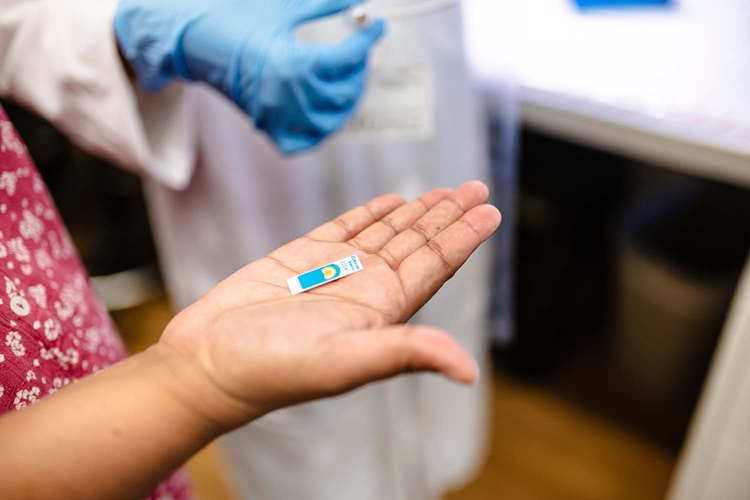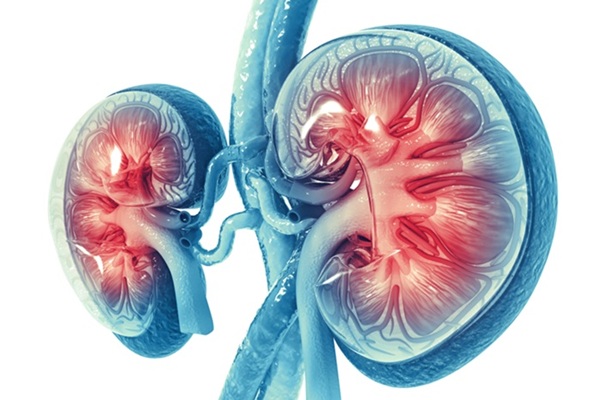New Method Using DNA Nanoballs to Revolutionize Pathogen Detection
|
By LabMedica International staff writers Posted on 08 Sep 2023 |

Throughout the recent COVID-19 pandemic, protein-based diagnostics played a significant role in rapid testing. However, developing high-quality antibodies for these methods is time-consuming. In contrast, nucleic acid-based approaches offer advantages in terms of development ease, sensitivity, and flexibility. Scientists have now pioneered a novel technique using DNA Nanoballs for pathogen detection that could simplify nucleic acid testing and revolutionize pathogen identification. Their research could pave the way for a simple electronic-based test to quickly and affordably identify various nucleic acids in diverse scenarios.
The methodology developed by researchers at Karolinska Institute (Stockholm, Sweden) combined Molecular Biology (specifically DNA Nanoball generation) with electronics (electric impedance-based quantification) to create this groundbreaking detection tool. They are cautiously optimistic about its potential to identify a range of pathogenic agents in real-world settings. The team modified an isothermal DNA amplification reaction called LAMP to produce tiny DNA nanoballs measuring 1-2μM if the pathogen was present in the sample. These nanoballs are then guided through tiny channels and electrically identified as they pass between two electrodes. The method has demonstrated impressive sensitivity, capable of detecting as few as 10 target molecules, and provides rapid results in under an hour using a compact, stationary system.
This label-free detection method has the potential to accelerate the development of new diagnostic kits. By combining affordable mass-produced electronics with lyophilized reagents, it could become a cost-effective, widely accessible, and scalable point-of-care device. Currently, the research team is actively exploring applications in fields such as environmental monitoring, food safety, virus detection, and antimicrobial resistance testing. They are also considering licensing options and establishing a startup to leverage this technology, having recently applied for a patent.
“Fast and accurate detection of genetic material is key for diagnosis, especially so in response to the emergence of novel pathogens,” said principal investigator Vicent Pelechano.
Related Links:
Karolinska Institute
Latest Molecular Diagnostics News
- Blood Protein Profiles Predict Mortality Risk for Earlier Medical Intervention
- First Of Its Kind Blood Test Detects Gastric Cancer in Asymptomatic Patients
- Portable Molecular Test Detects STIs at POC in 15 Minutes
- Benchtop Analyzer Runs Chemistries, Immunoassays and Hematology in Single Device
- POC Bordetella Test Delivers PCR-Accurate Results in 15 Minutes
- Pinprick Blood Test Could Detect Disease 10 Years Before Symptoms Appear
- Refined C-Reactive Protein Cutoffs Help Assess Sepsis Risk in Preterm Babies
- Blood Test Accurately Detects Brain Amyloid Pathology in Symptomatic Patients
- New Molecular Test Improves Diagnostic Accuracy of Lyme Disease
- New Genetic Test Enables Faster Diagnosis of Rare Diseases
- Urine Test Detects Inherited Neuropathy Missed by Genetic Screening
- Genomic Test Predicts Risk of SCC Metastasis
- Microfluidic Device Predicts Pancreatic Cancer Recurrence After Surgery
- New Molecular Test Simultaneously Detects Three Major Fungal Infections
- Blood Test Guides More Effective Ovarian Cancer Treatment
- Liquid Biopsy Test to Enable Earlier Diagnosis of Numerous Cancer Types
Channels
Clinical Chemistry
view channel
Chemical Imaging Probe Could Track and Treat Prostate Cancer
Prostate cancer remains a leading cause of illness and death among men, with many patients eventually developing resistance to standard hormone-blocking therapies. These drugs often lose effectiveness... Read more
Mismatch Between Two Common Kidney Function Tests Indicates Serious Health Problems
Creatinine has long been the standard for measuring kidney filtration, while cystatin C — a protein produced by all human cells — has been recommended as a complementary marker because it is influenced... Read moreHematology
view channel
Platelet Activity Blood Test in Middle Age Could Identify Early Alzheimer’s Risk
Early detection of Alzheimer’s disease remains one of the biggest unmet needs in neurology, particularly because the biological changes underlying the disorder begin decades before memory symptoms appear.... Read more
Microvesicles Measurement Could Detect Vascular Injury in Sickle Cell Disease Patients
Assessing disease severity in sickle cell disease (SCD) remains challenging, especially when trying to predict hemolysis, vascular injury, and risk of complications such as vaso-occlusive crises.... Read more
ADLM’s New Coagulation Testing Guidance to Improve Care for Patients on Blood Thinners
Direct oral anticoagulants (DOACs) are one of the most common types of blood thinners. Patients take them to prevent a host of complications that could arise from blood clotting, including stroke, deep... Read moreImmunology
view channel
Gene Signature Test Predicts Response to Key Breast Cancer Treatment
DK4/6 inhibitors paired with hormone therapy have become a cornerstone treatment for advanced HR+/HER2– breast cancer, slowing tumor growth by blocking key proteins that drive cell division.... Read more
Chip Captures Cancer Cells from Blood to Help Select Right Breast Cancer Treatment
Ductal carcinoma in situ (DCIS) accounts for about a quarter of all breast cancer cases and generally carries a good prognosis. This non-invasive form of the disease may or may not become life-threatening.... Read moreMicrobiology
view channel
Rapid Assay Identifies Bloodstream Infection Pathogens Directly from Patient Samples
Bloodstream infections in sepsis progress quickly and demand rapid, precise diagnosis. Current blood-culture methods often take one to five days to identify the pathogen, leaving clinicians to treat blindly... Read more
Blood-Based Molecular Signatures to Enable Rapid EPTB Diagnosis
Extrapulmonary tuberculosis (EPTB) remains difficult to diagnose and treat because it spreads beyond the lungs and lacks easily accessible biomarkers. Despite TB infecting 10 million people yearly, the... Read more
15-Minute Blood Test Diagnoses Life-Threatening Infections in Children
Distinguishing minor childhood illnesses from potentially life-threatening infections such as sepsis or meningitis remains a major challenge in emergency care. Traditional tests can take hours, leaving... Read more
High-Throughput Enteric Panels Detect Multiple GI Bacterial Infections from Single Stool Swab Sample
Gastrointestinal (GI) infections are among the most common causes of illness worldwide, leading to over 1.7 million deaths annually and placing a heavy burden on healthcare systems. Conventional diagnostic... Read morePathology
view channel
AI Tool Rapidly Analyzes Complex Cancer Images for Personalized Treatment
Complex digital biopsy images that typically take an expert pathologist up to 20 minutes to assess can now be analyzed in about one minute using a new artificial intelligence (AI) tool. The technology... Read more
Diagnostic Technology Performs Rapid Biofluid Analysis Using Single Droplet
Diagnosing disease typically requires milliliters of blood drawn at clinics, depending on needles, laboratory infrastructure, and trained personnel. This process is often painful, resource-intensive, and... Read moreTechnology
view channel
AI Saliva Sensor Enables Early Detection of Head and Neck Cancer
Early detection of head and neck cancer remains difficult because the disease produces few or no symptoms in its earliest stages, and lesions often lie deep within the head or neck, where biopsy or endoscopy... Read more
AI-Powered Biosensor Technology to Enable Breath Test for Lung Cancer Detection
Detecting lung cancer early remains one of the biggest challenges in oncology, largely because current tools are invasive, expensive, or unable to identify the disease in its earliest phases.... Read moreIndustry
view channel
Abbott Acquires Cancer-Screening Company Exact Sciences
Abbott (Abbott Park, IL, USA) has entered into a definitive agreement to acquire Exact Sciences (Madison, WI, USA), enabling it to enter and lead in fast-growing cancer diagnostics segments.... Read more




 assay.jpg)

















